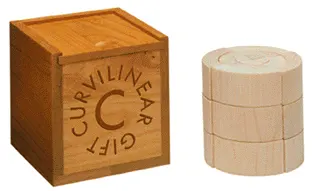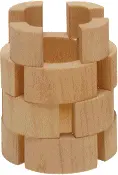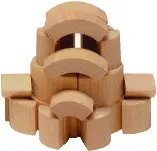The Curvilinear Gifts
The Curvilinear Series of Gifts was developed, like many of the Froebel Gifts, after Froebel’s death. Froebel had laid the philosophical foundation for these Gifts in his book Education by Development, but their use was not formalized until much later. Purists have argued against adding to the traditional Gift series, yet Froebel was clearly advocating the use of the curvilinear solids in his writings.
We developed our Curvilinear Gift as a modification of the cylinder set sold by the Milton Bradley Company. We divided the cylinder into three concentric rings 1/2″ thick as they did, but only 3 layers vertically instead of four. In this way, the 3-fold division is maintained in both directions.


The use of the Curvilinear Gifts were championed in the United States by Belle Woodson, an instructor at the Chicago Kindergarten College and by Minnie Maud Glidden, a Kindergartner and instructor at the Pratt Institute. Both women were colleagues of Elizabeth Harrison, who included their ideas in her book The Kindergarten Building Gifts. Whether the Curvilinear Series were widely used is not yet clear, but they definitely add a wonderful dimension to block play and all its Froebelian aspects.
The Curvilinear Gift can be thought of as a variation on Gift 5. It has enlarged the Gift 2 cylinder from 2″ to 3″ just as Gift 5 did for the cube. The Curvilinear Gift is also a more complicated dissection and therefore more suitable for an older child. Like Gift 5, this new Gift is especially suited to architectural constructions.
The introduction of the Curvilinear series came long after Frank Lloyd Wright had left the nursery, but he was known to use the Gifts as a scratch pad for designs. Frank Lloyd Wright utilized similar curves in his designs, including the Guggenheim Museum and the Hawaiian home he designed for Marilyn Monroe.

PRESENTATION
The Presentation of this Gift is the same as the other. The box is inverted and the lid is removed, allowing the blocks to remain
intact as a whole cylinder. The child will recognize the cylinder form and inspect and examine the characteristics which distinguish
them from the other Froebel blocks. The child may note the number of divisions and their axis.
FORMS OF LIFE
As with the other Gifts, children will use the Curvilinear Gift to construct things in their world. This can also be imaginative
creations like an igloo, a castle, or three chairs for the story of Goldilocks and the Three Bears. Make sure the children make use of
all 36 pieces of the Curvilinear Gift, as the idea of completeness and the whole are an important part of Gift play.
FORMS OF KNOWLEDGE
Children can play at dividing the Curvilinear cylinder into halves, thirds, quarters, etc. Concepts of ring, disc, arc, diameter,
radius and concentric can be discovered thorough play. The arcs can be rotated in different directions to prompt discussions of “curving over”
and “curving under.” The quarter circle arcs of the Curvilinear Gift can also be used by older children to form letters of the alphabet.
FORMS OF BEAUTY
As with the Gift 8 rings and half-rings, the Curvilinear Gift produces some elegant and beautiful designs. Younger children might start
with fewer pieces (one layer of 12 pieces) and gradually work up to using the entire Gift in pattern-making.
